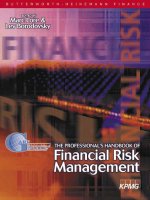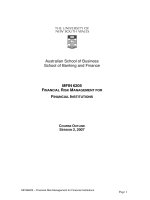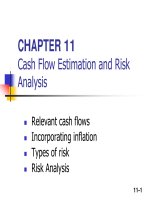Elements of financial risk management chapter 11
Bạn đang xem bản rút gọn của tài liệu. Xem và tải ngay bản đầy đủ của tài liệu tại đây (1.24 MB, 81 trang )
1
Option Risk Management
Elements of
Financial Risk Management
Chapter 11
Peter Christoffersen
Elements of Financial Risk Management Second Edition © 2012 by Peter Christoffersen
Overview
2
• In this chapter, we try to incorporate derivative securities
into the portfolio risk model
• The chapter is structured as follows:
• We define the delta of an option, which provides a linear
approximation to the nonlinear option price. We then present
delta formulas from the various models introduced in the
previous chapter
• We establish the delta-based approach to portfolio risk
management. The idea behind this approach is to linearize
the option return and thereby make it fit into the risk models.
The downside of this approach is that it ignores the key
asymmetry in option payoffs.
Elements of Financial Risk Management Second Edition © 2012 by Peter Christoffersen
Overview
3
• We define the gamma of an option, which gives a secondorder approximation of the option price as a function of the
underlying asset price
• We use gamma of an option to construct a quadratic model
of the portfolio return distribution. We discuss two
implementations of the quadratic model: one relies on the
Cornish-Fisher approximation and the other relies on the
Monte Carlo simulation technique
Elements of Financial Risk Management Second Edition © 2012 by Peter Christoffersen
Overview
• We will measure the risk of options using the full
valuation method, which relies on an accurate but
computationally intensive version of the Monte Carlo
simulation technique
• We illustrate all the suggested methods in a simple
example. We then discuss a major pitfall in the use of the
linear and quadratic approximations in another numerical
example. This pitfall, in turn, motivates the use of the full
valuation model
Elements of Financial Risk Management Second Edition © 2012 by Peter Christoffersen
4
Option Delta
5
• The delta of an option is defined as the partial derivative of
the option price with respect to the underlying asset price, St.
• For puts and calls, we define
• The option price for a generic underlying asset price, S, is
approximated by
• where St is the current price of the underlying asset
Elements of Financial Risk Management Second Edition © 2012 by Peter Christoffersen
Option Delta
6
• The delta of an option provides a linear approximation to
the nonlinear option price, where the approximation is
reasonably good for asset prices close to the current price
but gets gradually worse for prices that deviate significantly
from the current price
• To a risk manager, the poor approximation of delta to the
true option price for large underlying price changes is
clearly unsettling
• Risk management is all about large price changes, and we
will therefore consider more accurate approximations here
Elements of Financial Risk Management Second Edition © 2012 by Peter Christoffersen
Figure 11.1: Call Option Price and Delta
Approximation
Elements of Financial Risk Management Second Edition © 2012 by Peter Christoffersen
7
Black-Scholes-Merton Model
8
• The Black-Scholes-Merton (BSM) formula for a European
call option price
• where (*) is the cumulative density of a standard normal
variable, and
• Using basic calculus, we can take the partial derivative of
the option price with respect to the underlying asset price,
St, as follows:
Elements of Financial Risk Management Second Edition © 2012 by Peter Christoffersen
Black-Scholes-Merton Model
9
• We refer to this as the delta of the option, and it has the
interpretation that for small changes in St the call option price
will change by (d)
• Notice that as (*) is the normal cumulative density function,
which is between zero and one, we have
• so that the call option price in the BSM model will change
in the same direction as the underlying asset price, but the
change will be less than one-for-one.
Elements of Financial Risk Management Second Edition © 2012 by Peter Christoffersen
Black-Scholes-Merton Model
10
• For a European put option, we have the put-call parity stating
that
• so that we can easily derive
• Notice that we have
• so that BSM put option price moves in the opposite
direction of underlying asset, and again option price will
change by less than the underlying asset price
Elements of Financial Risk Management Second Edition © 2012 by Peter Christoffersen
Black-Scholes-Merton Model
• In the case where a dividend or interest is paid on the
underlying asset at a rate of q per day, deltas will be
• where
Elements of Financial Risk Management Second Edition © 2012 by Peter Christoffersen
11
Figure 11.2: The Delta of a Call Option (top) and a
Put Option (bottom)
Elements of Financial Risk Management Second Edition © 2012 by Peter Christoffersen
12
Figure 11.3: The Delta of Three Call Options
In-the-money
At-the-money
Out-of-the-money
Elements of Financial Risk Management Second Edition © 2012 by Peter Christoffersen
13
The Binomial Tree Model
14
• Option deltas can be computed using binomial trees
• This is important for American put options for which early
exercise may be optimal, which will impact the current
option price and also the option delta
• The black font shows the American put option price at each
node. The green font shows the option delta
• The delta at point A (that is at present) can be computed
very easily in binomial trees simply as
Elements of Financial Risk Management Second Edition © 2012 by Peter Christoffersen
15
Table 11.1: Delta of American Put Option
Market Variables
S t=
Annual r =
1000
D
0.05
1528.47
Contract Terms
0.00
X=
1100
T=
0.25
B
1236.31
Parameters
-0.19
Annual Vol=
0.6
tree steps =
2
dt=
0.125
u=
53.48
A
E
1.236311
1000.00
1000.00
d=
0.808858
-0.56
RNP =
0.461832
180.25
Stock is black
American Put Delta is Green
American Put Price is Red
100.00
C
808.86
-1.00
291.14
F
654.25
445.75
Elements of Financial Risk Management Second Edition © 2012 by Peter Christoffersen
The Binomial Tree Model
16
• A similar formula can be used for European puts as well as
for call options of each style
• Note that delta was already used in Chapter 10 to identify
the number of units in the underlying asset we needed to
buy to hedge the sale of one option
• Delta changes in each point of the tree, which shows that
option positions require dynamic hedging in order to
remain risk free
Elements of Financial Risk Management Second Edition © 2012 by Peter Christoffersen
The Gram-Charlier Model
17
• As the delta is a partial derivative of an option pricing
model with respect to the underlying asset price, it is
fundamentally model dependent.
• The preceding deltas were derived from the BSM model,
but different option pricing models imply different
formulas for the deltas
• We saw in the previous chapter that the BSM model
sometimes misprices traded options quite severely
• We therefore want to consider using more accurate option
pricing models for calculating the options delta
Elements of Financial Risk Management Second Edition © 2012 by Peter Christoffersen
The Gram-Charlier Model
18
• In the case of the Gram-Charlier option pricing model, we have
• and the partial derivative with respect to the asset price in
this case is
Elements of Financial Risk Management Second Edition © 2012 by Peter Christoffersen
The Gram-Charlier Model
19
• which collapses to the BSM delta of (d) when skewness,
11, and excess kurtosis, 21, are both zero
• Again, we can easily calculate the put option delta from
Elements of Financial Risk Management Second Edition © 2012 by Peter Christoffersen
GARCH Option Pricing Models
20
• Calculating deltas from the general GARCH option pricing
model, we face the issue that the option price is not available
in closed form but must be simulated
• We have in general
• which we compute by simulation as
• where
is the hypothetical GARCH asset price on
option maturity date
for Monte Carlo simulation
path i, where the simulation is done under the risk-neutral
distribution
Elements of Financial Risk Management Second Edition © 2012 by Peter Christoffersen
GARCH Option Pricing Models
21
• The partial derivative of the GARCH option price with
respect to underlying asset price can be shown to be
• where the function 1(*) takes the value 1 if the argument is
true and zero otherwise.
• GARCH delta must also be found by simulation as
• Where
asset price
is again the simulated future risk-neutral
Elements of Financial Risk Management Second Edition © 2012 by Peter Christoffersen
GARCH Option Pricing Models
22
• The delta of the European put option can still be derived
from the put-call parity formula
• In the special case of closed-form GARCH process, we have
the European call option pricing formula
• and the delta of the call option is
• The formula for P1 is given in the appendix to the previous
chapter
Elements of Financial Risk Management Second Edition © 2012 by Peter Christoffersen
The Portfolio Risk Using Delta
23
• Consider a portfolio consisting of just one (long) call option
on a stock
• The change in the dollar value of the option portfolio,
DVPF,t+1, is then just the change in the value of option
• Using the delta of the option, we have that for small
changes in the underlying asset price
• Defining geometric returns on underlying stock as
Elements of Financial Risk Management Second Edition © 2012 by Peter Christoffersen
The Portfolio Risk Using Delta
24
• and combining the previous three equations, we get the
change in the option portfolio value to be
• The upshot of this formula is that we can write the change
in dollar value of the option as a known value t times the
future return of the underlying asset, Rt+1
• Notice that a portfolio consisting of an option on a stock
corresponds to a stock portfolio with shares
• Similarly, we can think of holdings in underlying asset as
having a delta of 1 per share of underlying asset
• Trivially, the derivative of a stock price with respect to the
stock
price
is
1
Elements of Financial Risk Management Second Edition © 2012 by Peter Christoffersen
The Portfolio Risk Using Delta
25
• Thus, holding one share corresponds to having =1, and
holding 100 shares corresponds to having =100
• And, a short position of 10 identical calls corresponds to
setting =-10c, where c is delta of each call option
• The delta of a short position in call options is negative, and the
delta of a short position in put options is positive as the delta
of a put option itself is negative
• The variance of the portfolio in delta-based model is
• where 2t+1 is the conditional variance of the return on the
underlying stock
Elements of Financial Risk Management Second Edition © 2012 by Peter Christoffersen









